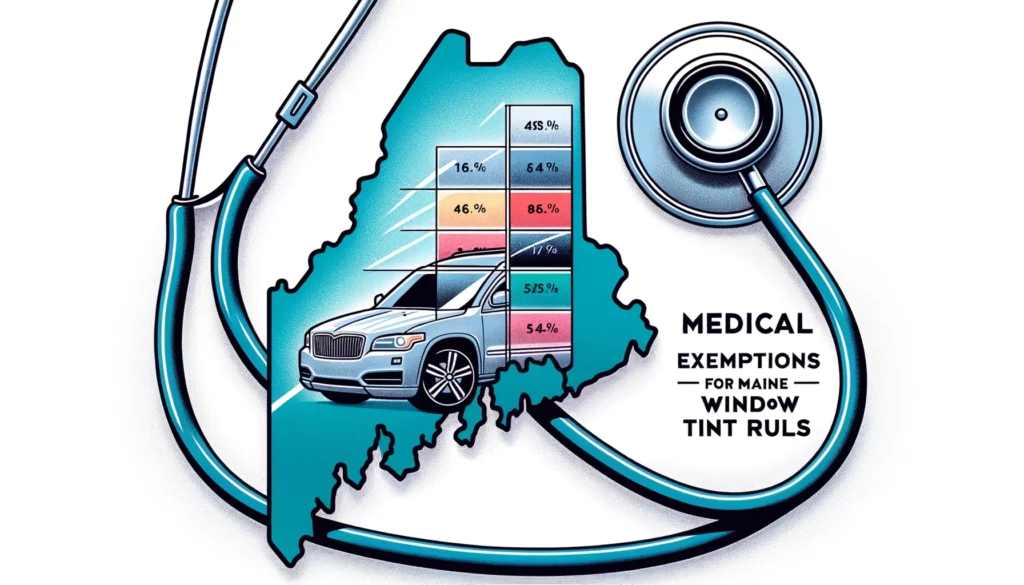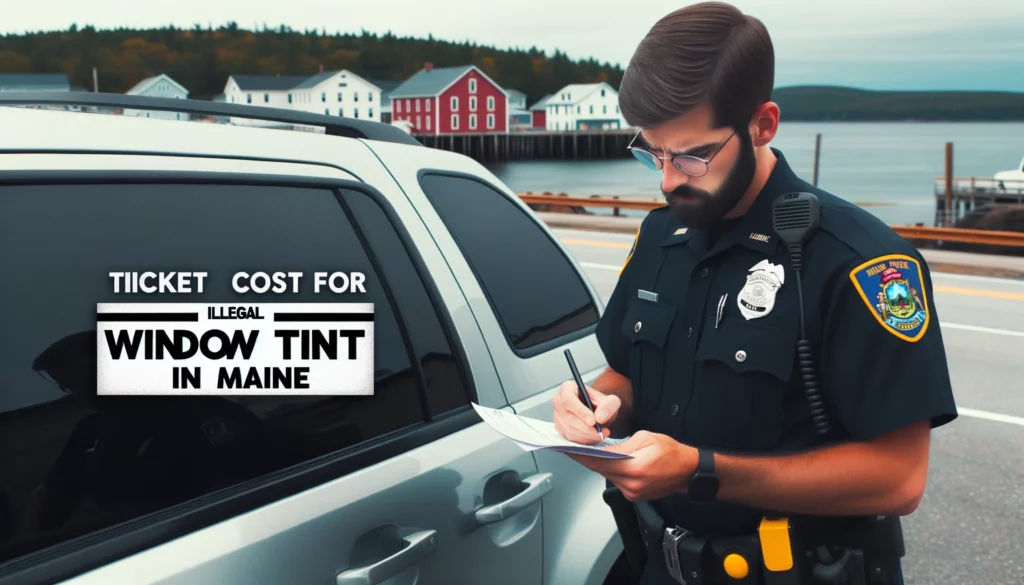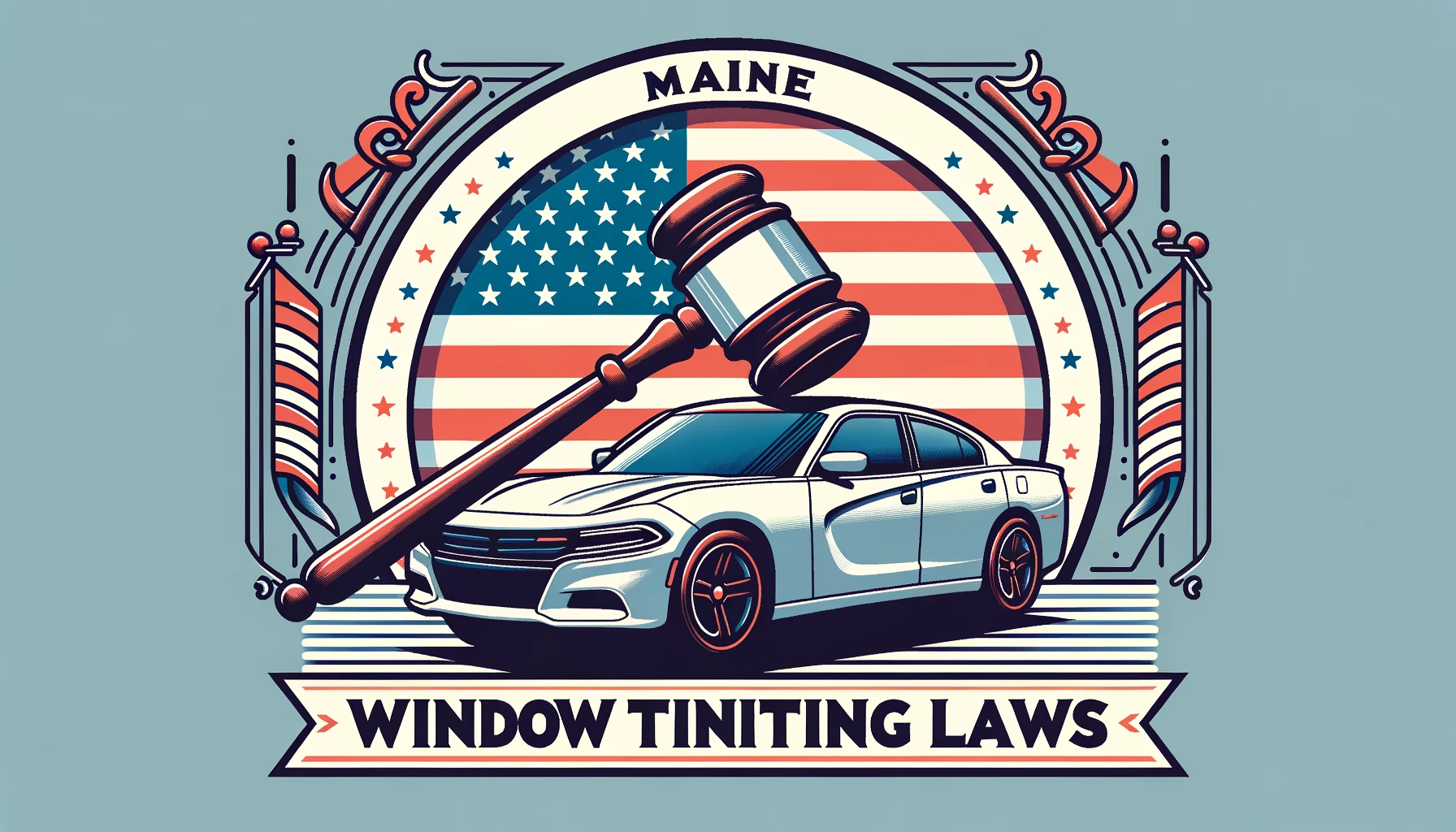Darkest legal tint for Sedans in Maine
- Windshield: Non-reflective tint allowed above the AS-1 line or top 5 inches.
- Front Side windows: Must allow more than 35% of light in.
- Back Side windows: Must allow more than 35% of light in; no restrictions with outside rear view mirrors on both sides.
- Rear window: Must allow more than 35% of light in; no restrictions with outside rear view mirrors on both sides.
Darkest legal tint for SUV and Vans in Maine
- Windshield: Non-reflective tint allowed above the AS-1 line or top 5 inches.
- Front Side windows: Must allow more than 35% of light in.
- Back Side windows: Any darkness can be used.
- Rear window: Any darkness can be used.
Maine Tinting Regulations

Maine, with its picturesque landscapes and coastal beauty, is not just known for its lobsters and lighthouses. If you’re a vehicle owner in the Pine Tree State, you might be considering window tinting for aesthetics, privacy, or protection from the sun. But before you proceed, it’s crucial to be aware of Maine’s specific tinting regulations. Let’s dive into the nitty-gritty of these rules.
A Glimpse into Maine’s Window Tinting Laws
Maine’s window tinting laws were first introduced in 1989 and have undergone several revisions since. At the heart of these regulations is the concept of Visible Light Transmission (VLT). VLT refers to the percentage of visible light that a window tint allows to pass through. The state has set specific VLT percentages for different types of vehicles and windows to ensure safety and clarity for drivers.
Why Adhering to Tinting Laws is Essential
Understanding and complying with Maine’s tinting regulations isn’t just about avoiding penalties. It’s about ensuring that your vehicle is safe for you and other road users. Overly dark tints can obscure a driver’s view, especially during nighttime or in low-light conditions, leading to potential accidents. Moreover, adhering to these laws reflects a driver’s responsibility and respect for state regulations, ensuring a harmonious driving environment for everyone.
Delving into the Details: Sedans
- Windshield: You can have a non-reflective tint, but it should only be above the AS-1 line or the top 5 inches of the windshield. This ensures you have a clear view of the road while driving.
- Front Side Windows: These need to allow more than 35% of light in. It’s a safety measure ensuring drivers can clearly see pedestrians, cyclists, and other vehicles.
- Back Side Windows: They should also permit more than 35% of light. However, if your sedan has outside rearview mirrors on both sides, there are no specific restrictions.
- Rear Window: The rules mirror the back side windows. More than 35% of light should pass through unless you have those outside rearview mirrors on both sides.
What About SUVs and Vans?
- Windshield: The rules remain consistent with sedans. Only a non-reflective tint is allowed above the AS-1 line or the top 5 inches.
- Front Side Windows: They should let in more than 35% of light, ensuring drivers have a clear and unobstructed view.
- Back Side Windows: SUVs and vans get a bit more leeway here. You can choose any darkness of tint for these windows.
- Rear Window: Again, any level of darkness is permissible, offering greater privacy for passengers and any items you might be transporting.
A Few More Things to Keep in Mind
- Reflective or mirrored tints? Maine says no. Only non-reflective tints are allowed.
- While some states have restrictions on tint colors, Maine is pretty relaxed. There are no specific tint colors that are against the law.
- If you’re thinking about that super dark tint, remember: safety first. Overly dark tints can hinder your visibility, especially during nighttime or foggy conditions.
- Always ensure your tinting adheres to the state’s regulations. Not only does this keep you on the right side of the law, but it also ensures a safer driving environment for everyon
Additional Regulations and Considerations Under Maine Window Tinting Laws
Requirement for Dual Side Mirrors
While tinting can offer privacy and protection from the sun, it can also potentially reduce visibility, especially if rear windows are heavily tinted. To counteract this and ensure safety:
- Vehicles with a rear window tint that’s darker than the state’s standard regulations must be equipped with dual side mirrors.
- These mirrors ensure that drivers have an unobstructed view of the road and their surroundings, compensating for any reduced visibility due to the tint.
Restricted Tint Colors
Maine’s approach to tint colors is straightforward:
- The state prohibits the use of amber and yellow tints.
- This restriction ensures that there’s no confusion with traffic signals or emergency vehicle lights, maintaining road safety for all users.
Medical Exemptions for Maine Tint Laws

Imagine being highly sensitive to sunlight due to a medical condition. The sun’s rays, which most of us enjoy, could cause severe discomfort or even health risks for such individuals. In such cases, darker window tints can be a lifesaver, shielding them from excessive sunlight and UV exposure. This is where medical exemptions come into play.
How and When Can Medical Exemptions Be Granted?
Medical exemptions for window tinting in Maine are granted when an individual has a verified medical condition that necessitates protection from the sun’s rays beyond what standard tinting allows. Conditions might include, but are not limited to, severe sun allergies, lupus, or other photosensitive disorders.
It’s essential to understand that not all medical conditions will qualify for an exemption. The condition must be one where exposure to sunlight could exacerbate symptoms or pose a direct threat to health.
Navigating the Process in Maine
- Consultation with a Healthcare Professional: The journey begins with a visit to your doctor or healthcare provider. They will assess your condition and determine if a darker window tint is a necessary accommodation.
- Documentation: If your healthcare provider agrees that you need a medical exemption for window tinting, they will provide documentation. This typically includes a detailed letter explaining the medical necessity of the exemption.
- Reaching Out to the Authorities: With your medical documentation in hand, you’ll need to contact the office of the Chief of the State Police of Maine. They handle requests for medical tint exemptions.
- Review and Approval: The State Police will review your application and the provided medical documentation. If everything is in order and the need is genuine, they will grant the exemption.
- Keeping Proof Handy: Once you’ve received your exemption, it’s crucial to keep proof in your vehicle. Should you ever be stopped by law enforcement, this documentation will explain why your windows are tinted beyond the standard regulations.
A Few Things to Remember
- Medical exemptions are not a one-size-fits-all pass to have the darkest tint possible. The tint level allowed will align with the specific needs outlined in the medical documentation.
- Exemptions typically have an expiration date. Depending on the nature of your condition, you might need to renew your exemption periodically.
- Always ensure that your tinting, even with an exemption, is done professionally. This ensures the safety and effectiveness of the tint.
Window Film Certificates and Stickers In Maine
In the realm of window tinting, certificates and stickers serve as a badge of compliance. They’re a tangible proof that your vehicle’s window tint meets Maine’s regulations, ensuring that you’re on the right side of the law.
Window Film Certificates:
This is a document, typically provided by the installer or the manufacturer of the window film, that certifies the tint’s compliance with state regulations. It will often include details like:
- The manufacturer’s name and address
- The film’s solar reflectance and light transmittance values
- A statement of compliance with Maine’s tinting regulations
Stickers:
In addition to the certificate, vehicles with tinted windows in Maine should also display a sticker. This sticker, usually placed between the film and the glass on the driver’s side window, serves as a quick reference for law enforcement officers. It indicates that the vehicle’s tint is legal and has been installed by a certified professional.
The Importance of Having the Right Paperwork
You might wonder, “Why all the fuss about a piece of paper or a tiny sticker?” Well, there are a few compelling reasons:
- Avoiding Penalties: Driving with non-compliant window tint in Maine can lead to fines and potential legal hassles. Having the right certificate and sticker can save you from these unnecessary troubles.
- Resale Value: If you ever decide to sell your vehicle, having the proper tinting documentation can be a selling point. It assures potential buyers that the vehicle meets state regulations.
- Peace of Mind: Knowing that you’re compliant with the law allows you to enjoy the benefits of your tinted windows without any lingering worries.
Staying Updated and Compliant
Maine’s regulations around window tinting can evolve. It’s always a good idea to stay updated with the latest requirements. If you’re getting a new tint or replacing an old one, ensure that you receive the updated certificate and sticker. And remember, always choose a reputable installer who is familiar with Maine’s tinting regulations.
Penalties or Ticket Cost for Illegal Window Tint in Maine

Maine’s window tinting laws are pretty straightforward. They revolve around the concept of Visible Light Transmission (VLT) – the percentage of light a window tint allows to pass through. But what happens if you decide to go a shade darker than what’s legally allowed?
Minimum Fines
If you’re caught with illegal window tint in Maine, you can expect a minimum fine. While the exact amount can vary based on the discretion of the law enforcement officer, fines typically start at around $100 for first-time offenders.
Potential Additional Penalties
But the financial hit doesn’t stop at the initial fine. If your window tint is deemed illegal:
- Re-inspection Fees: You’ll likely be required to remove the non-compliant tint and have your vehicle re-inspected to ensure it now adheres to state regulations. This re-inspection can come with its own set of fees.
- Increased Insurance Premiums: Some insurance companies might view traffic violations, including illegal window tints, as a sign of risky behavior. This could potentially lead to an increase in your insurance premiums.
- Repeat Offender Penalties: If you’re caught multiple times with illegal tint, the fines can escalate. Repeat offenses might also lead to higher penalties or even the suspension of driving privileges in extreme cases.
Why Adhering to the Laws is Crucial
Beyond the financial implications, there are several reasons you’d want to stick to the legal limits:
- Safety First: Maine’s tinting regulations are in place to ensure the safety of drivers, pedestrians, and other road users. Overly dark tints can reduce visibility, especially in low-light conditions, increasing the risk of accidents.
- Avoiding Hassles: Being pulled over and ticketed is an inconvenience. It takes time out of your day, and there’s the added stress of dealing with potential court appearances or other legal processes.
- Peace of Mind: Knowing that your vehicle complies with all state regulations gives you peace of mind. You can drive confidently, enjoying the benefits of your window tint without the constant worry of potential penalties.
Conclusion
Maine’s window tinting laws strike a balance between personal customization and road safety. By setting clear standards on tint darkness, reflectivity, and other considerations, the state ensures drivers can enjoy the benefits of window tinting while maintaining clear visibility and safety on the road. It’s essential for vehicle owners to stay informed and compliant to enjoy a hassle-free driving experience in the Pine Tree State.
State of Maine Info: A Gem in New England
Ah, Maine! Often referred to as the “Pine Tree State” because of its vast, dense forests, this northeasternmost state in the U.S. has so much more to offer than just trees. From its rugged coastline to its picturesque towns, Maine truly is a treasure waiting to be discovered.
Geography and Climate
Maine is nestled right up in the northeastern corner of the United States. It’s bordered by New Hampshire to the west, the Canadian provinces of New Brunswick and Quebec to the northeast and northwest respectively, and the Atlantic Ocean to the southeast. The state’s topography is a delightful blend of rolling mountains, dense forests, and a jagged coastline dotted with lighthouses.
As for its climate, Maine experiences all four seasons in their full glory. Winters can be quite cold, especially inland, and it’s not uncommon for the state to be blanketed in snow. Summers, on the other hand, are warm but not stifling, making it a perfect getaway for those looking to escape the heat.
Economy and Industry
Historically, Maine’s economy thrived on shipbuilding, fishing, and logging. And while these industries still play a role, the state’s economy has diversified over the years. Today, Maine is known for its lobster and blueberries. In fact, Maine produces about 90% of the country’s blueberry crop! Tourism also plays a significant role, with visitors flocking to towns like Bar Harbor, Kennebunkport, and Portland throughout the year.
Culture and Lifestyle
Maine is more than just its landscapes and industries; it’s about the people and the culture they’ve built. Mainers, as they’re affectionately known, are known for their down-to-earth, friendly demeanor. There’s a certain charm to the way of life here, where community matters and traditions are held close.
The state is also a hub for art and literature. Remember the chilling tales of Stephen King? Yup, he’s a Mainer and has set many of his stories in this state. Maine’s beauty has inspired many, from painters to poets, and continues to do so.
Notable Attractions
- Acadia National Park: A haven for nature lovers, this national park offers hiking, camping, and breathtaking views of the Atlantic.
- Portland: A bustling city known for its art scene, historic Old Port, and, of course, the delectable seafood.
- Lighthouses: Maine’s coastline is dotted with iconic lighthouses like Portland Head Light, Bass Harbor Head Light, and many more. Each has its own story to tell.
- Festivals: From the Maine Lobster Festival to the Yarmouth Clam Festival, there’s always something happening.
Frequently Asked Questions
Are there different tint limits for SUVs and vans in Maine?
Yes, while the rules for windshields and front side windows remain the same, for back side windows and rear windows, any darkness can be used.
Are there any restrictions on tint colors in Maine?
Maine does not have specific tint colors that are against the law. However, amber and yellow tints are typically prohibited to avoid confusion with traffic signals or emergency vehicle lights.
Do tint manufacturers need certification in Maine?
Yes, manufacturers of window film must certify the film they sell in the state to ensure it meets Maine’s regulations.
Is a sticker required for legal window tinting in Maine?
While Maine does not mandate a sticker to identify legal tinting, it’s recommended to have one. This sticker, typically placed between the film and the glass on the driver’s side window, indicates the tint’s compliance with state regulations.
Are there medical exemptions for window tinting in Maine?
Yes, Maine law allows for medical exemptions. The Chief of the State Police may grant a certificate of exemption in cases of certain medical conditions.
What are the penalties for non-compliant window tint in Maine?
Violating Maine’s window tinting laws can result in a traffic infraction with a minimum fine of $100.
